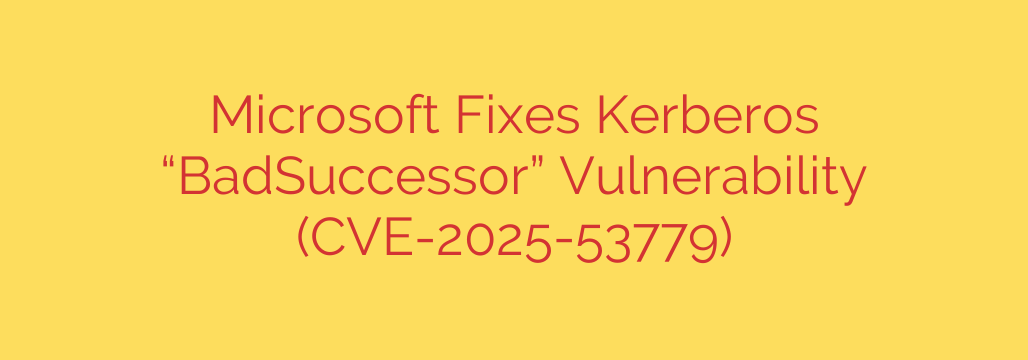
Critical Kerberos Vulnerability CVE-2025-53779: What You Need to Know and How to Fix It
A significant security flaw has been identified within the Microsoft Windows Kerberos protocol, a cornerstone of network authentication in most enterprise environments. Tracked as CVE-2025-53779 and dubbed the “BadSuccessor” vulnerability, this issue poses a severe risk, potentially allowing an attacker to gain elevated privileges on a compromised network.
Microsoft has released security updates to address this critical vulnerability, and administrators are strongly urged to take immediate action. Understanding the threat and the required steps is essential for protecting your organization’s infrastructure.
Understanding the “BadSuccessor” Kerberos Flaw
At its core, the CVE-2025-53779 vulnerability allows for a sophisticated privilege escalation attack. Kerberos is the default authentication service for Windows domain environments, responsible for verifying the identity of users and services. It uses encrypted “tickets” to grant access without repeatedly sending passwords over the network.
The “BadSuccessor” flaw exists in how the Key Distribution Center (KDC), a service running on Domain Controllers, processes certain types of Kerberos service tickets. An attacker who has already gained an initial foothold on a network—even with low-level user credentials—can exploit this vulnerability.
By crafting a malicious Kerberos ticket and presenting it to the KDC, an attacker can trick the system into granting them a service ticket with the privileges of a much more powerful account. In essence, an attacker can impersonate legitimate, high-privilege services within the domain.
The Impact: Why This Vulnerability is So Dangerous
The potential consequences of a successful exploit are severe and could lead to a full network compromise. The primary risks include:
- Complete Domain Compromise: The most critical threat is the ability to escalate privileges to the level of a Domain Administrator. An attacker achieving this could effectively seize control of the entire Active Directory domain, allowing them to create, modify, or delete user accounts, deploy ransomware, and exfiltrate sensitive data.
- Lateral Movement and Data Theft: By impersonating services like file shares or database servers, an attacker can move undetected across the network, accessing and stealing confidential information that would otherwise be inaccessible.
- Persistent Access: Once an attacker gains high-level privileges, they can create hidden backdoors and establish persistence, making them extremely difficult to detect and remove from the network.
This is not a theoretical threat. Because Kerberos is fundamental to Windows security, any vulnerability within it is a high-priority target for malicious actors.
Urgent Steps to Mitigate Risk: Patching and Protection
Protecting your network from CVE-2025-53779 requires swift and decisive action. Waiting to apply these patches significantly increases your organization’s exposure to attack.
1. Apply Security Updates Immediately
Microsoft has released patches for all affected versions of Windows Server. This is the single most important step you can take. This is not a patch to delay. Ensure your standard patching cycle is expedited to deploy these updates as soon as possible.
2. Prioritize Domain Controllers
Your Domain Controllers (DCs) are the heart of your Active Directory environment and run the vulnerable KDC service. These servers must be your top priority for patching. Applying the update to your DCs will immediately mitigate the primary attack vector.
3. Monitor for Anomalous Kerberos Activity
Even after patching, maintaining vigilance is crucial. Security teams should monitor for unusual Kerberos-related events in their Security Information and Event Management (SIEM) systems. Look for:
- Anomalies in Kerberos service ticket (TGS-REQ) requests.
- Unusual logon patterns or access attempts related to high-value service accounts.
- Event ID 4769 (A Kerberos service ticket was requested) with suspicious service names or failure codes.
4. Enforce the Principle of Least Privilege
This vulnerability highlights the importance of strong security hygiene. Ensure that service accounts within your domain are configured with the minimum level of privilege necessary to perform their function. An attacker can only escalate to the level of the service they can impersonate. By limiting the power of these accounts, you reduce the potential damage of a successful exploit.
In conclusion, the CVE-2025-53779 “BadSuccessor” vulnerability represents a clear and present danger to Windows environments. The availability of a patch means that the path to exploitation is now known to attackers. Proactive patching and vigilant monitoring are essential to securing your network against this critical threat.
Source: https://www.helpnetsecurity.com/2025/08/13/microsoft-fixes-badsuccessor-kerberos-vulnerability-cve-2025-53779/








